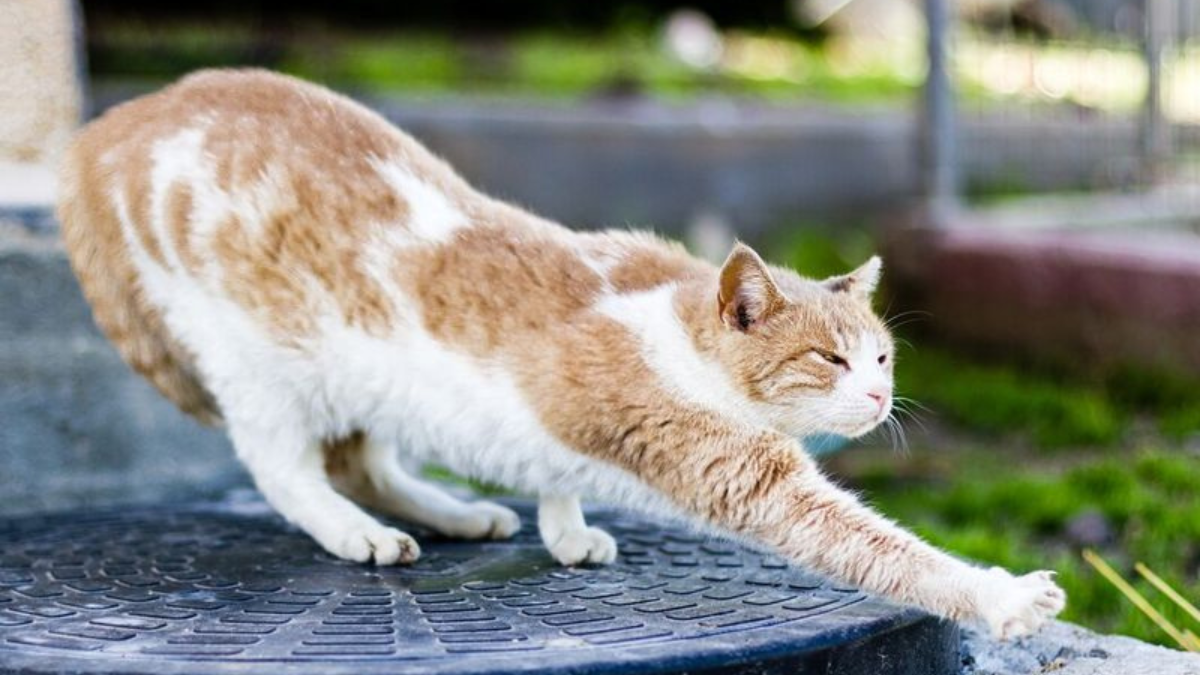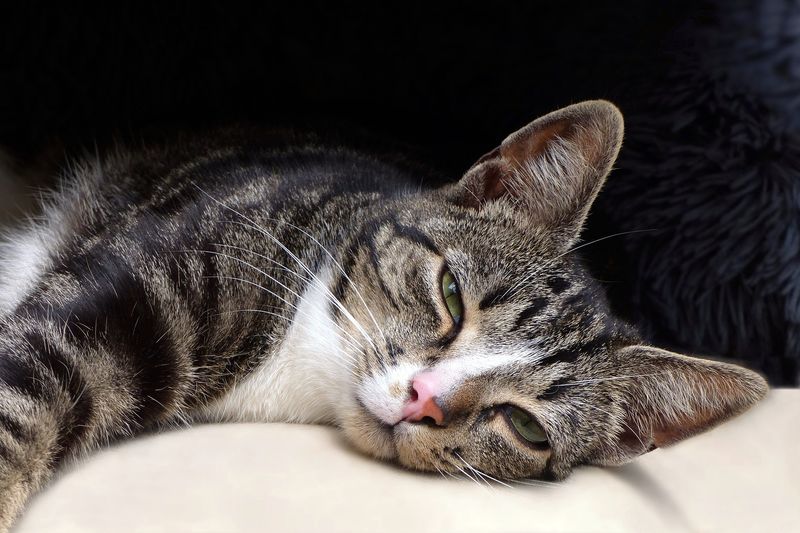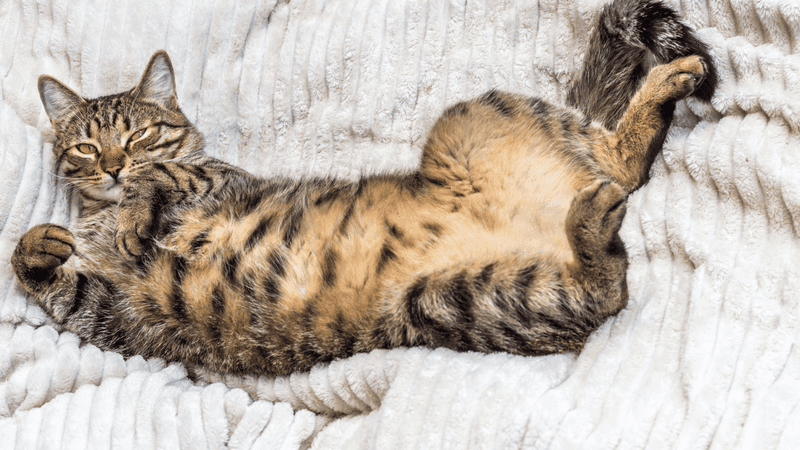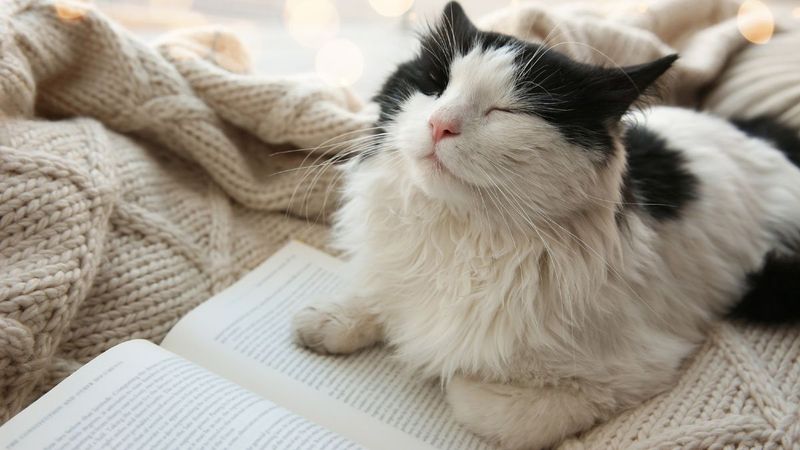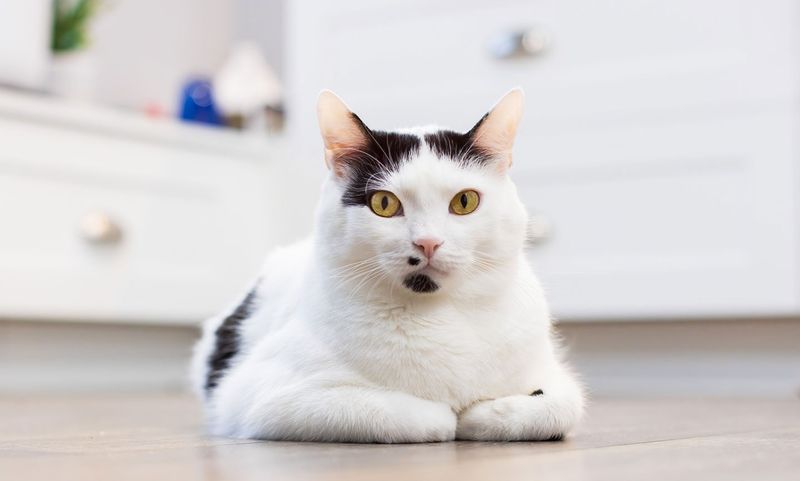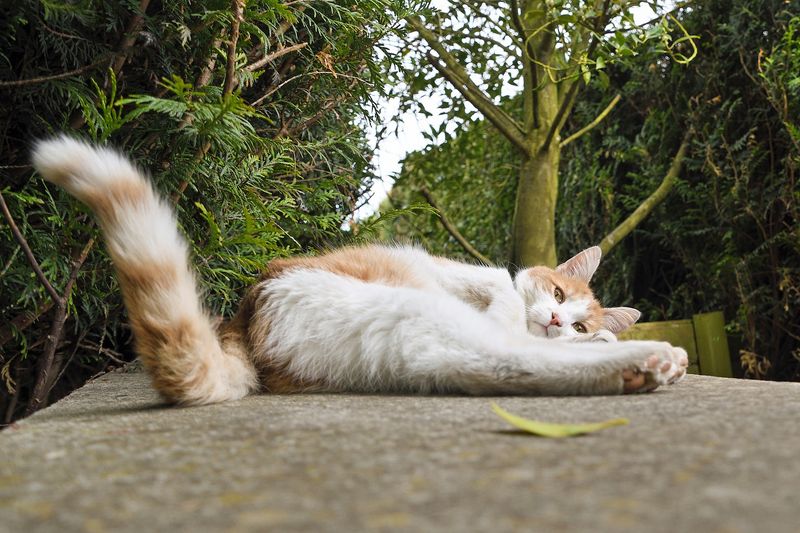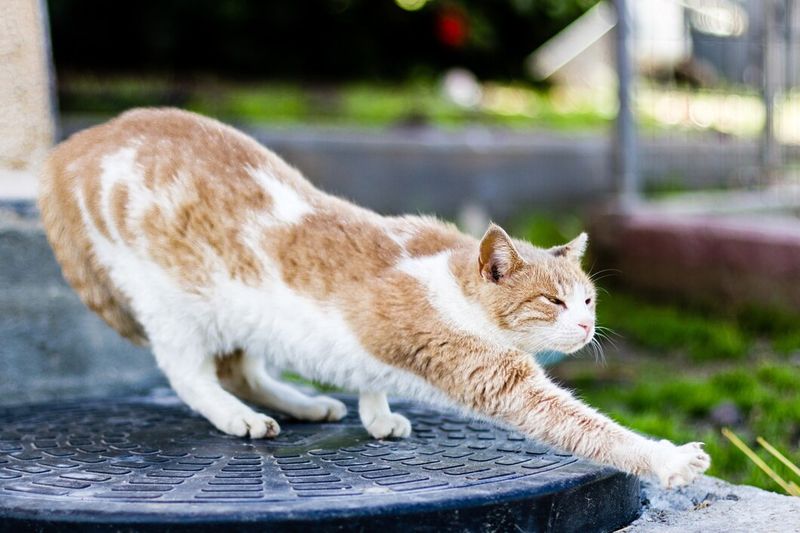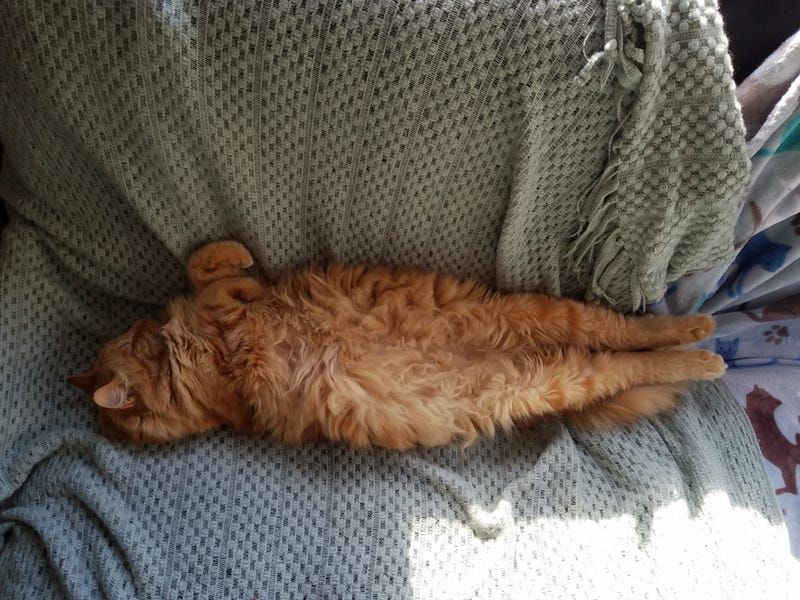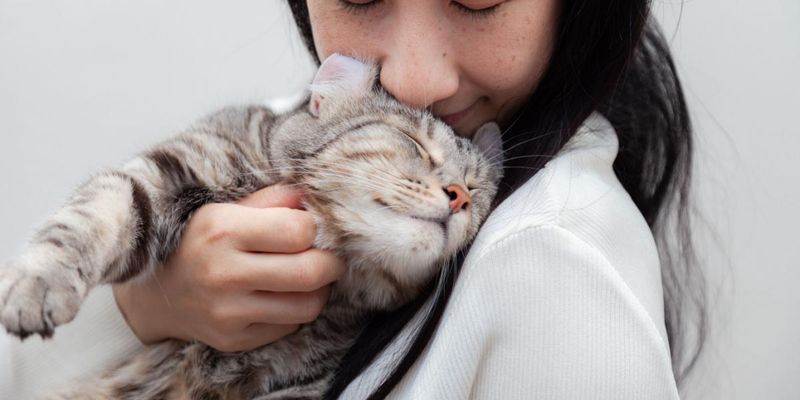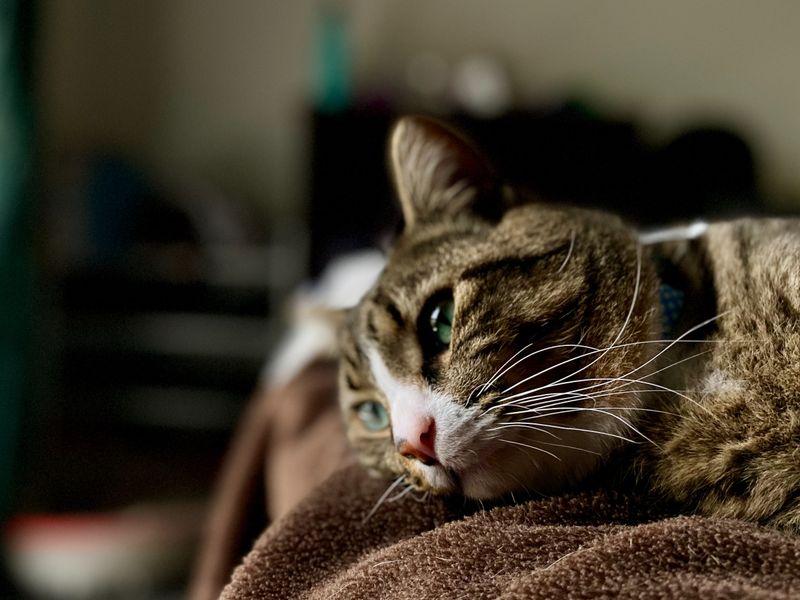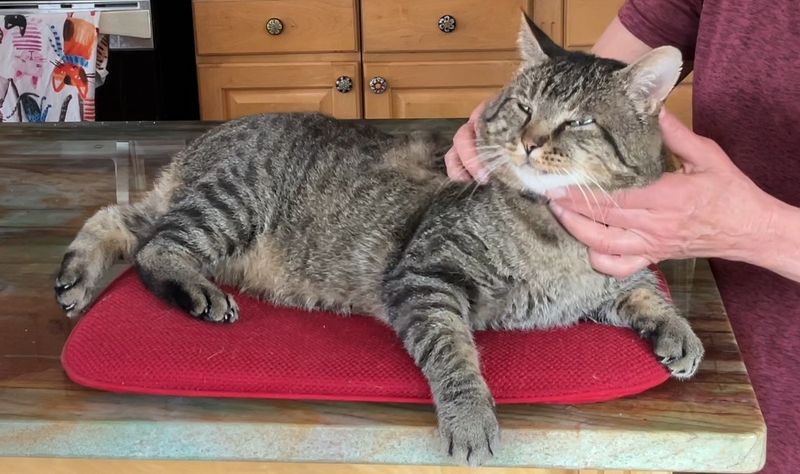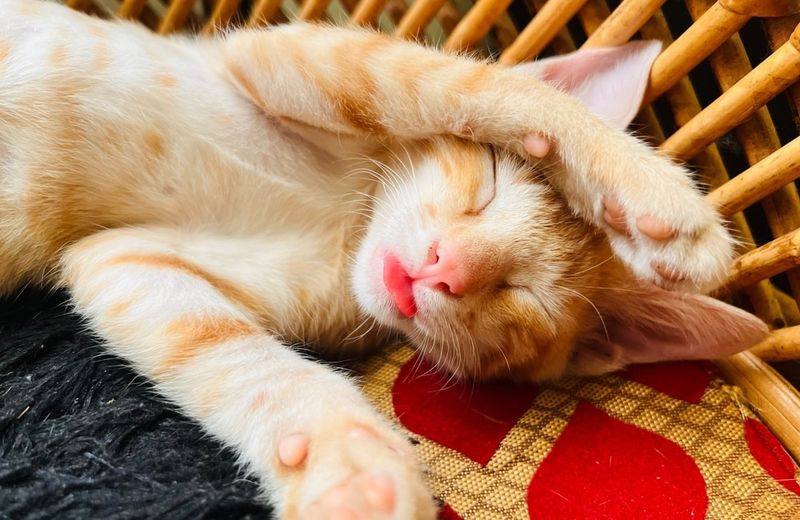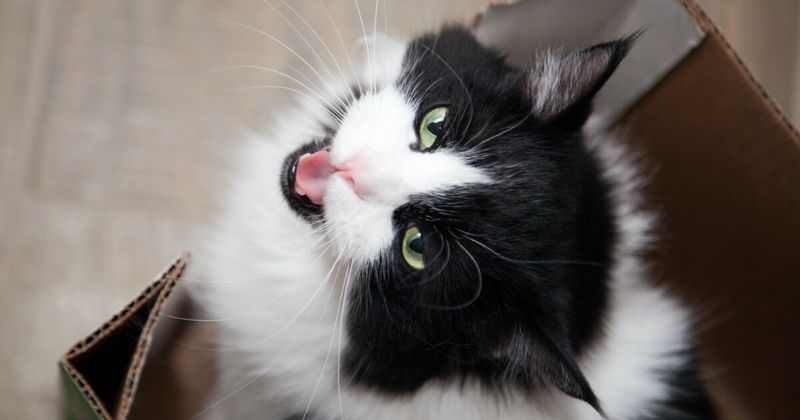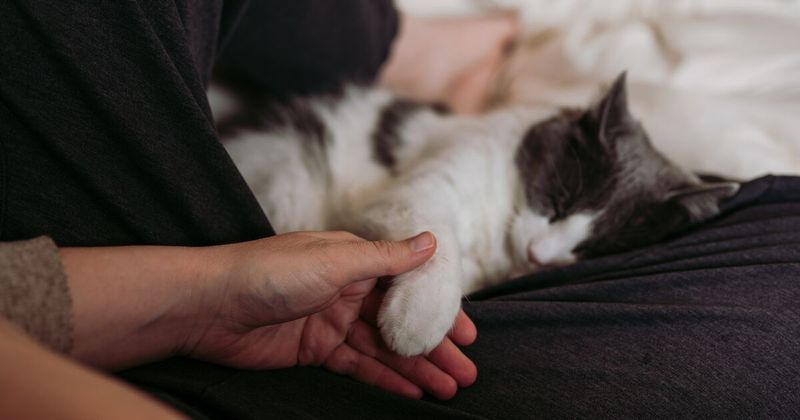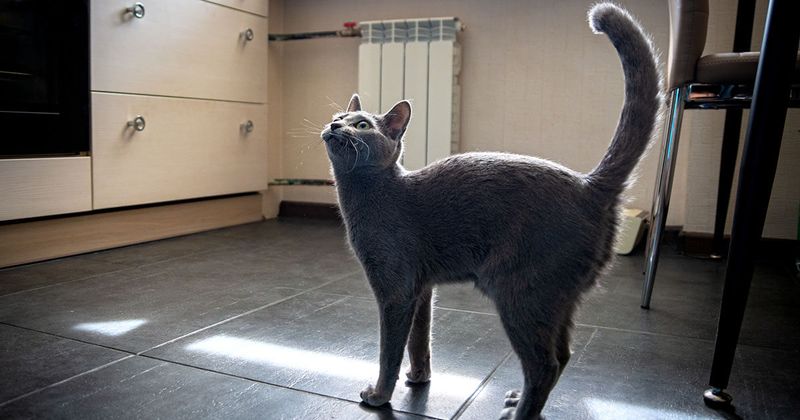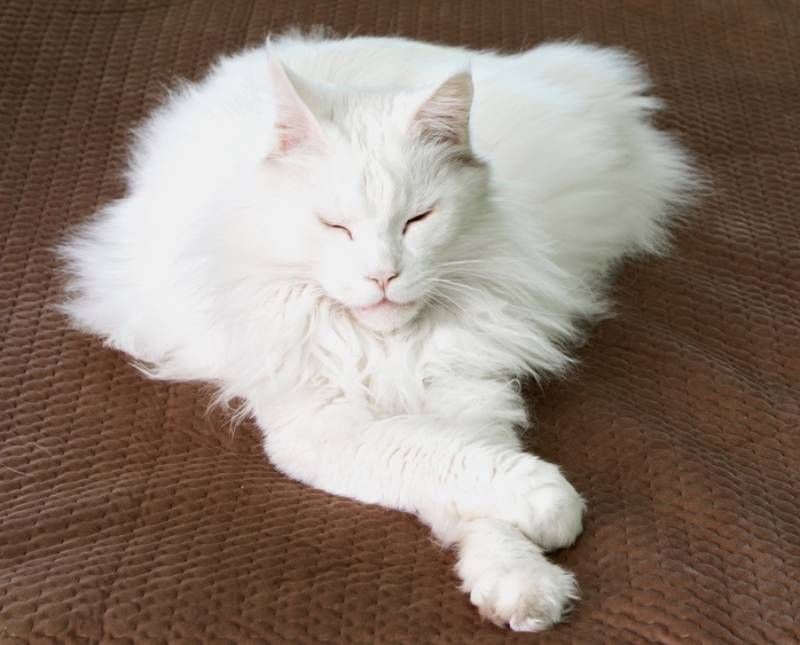📖 Table of Content:
- 1. Slow Blinks of Trust
- 2. Belly Display Bonanza
- 3. Kneading Dough Paws
- 4. Purr-fect Vibrations
- 5. Loaf Mode Activated
- 6. Floppy Tail Signals
- 7. Sleepy Stretching Sessions
- 8. Whisker Relaxation Mode
- 9. Exposed Toe Beans
- 10. Side Sleeping Surrender
- 11. Gentle Head Bumps
- 12. Relaxed Ear Positions
- 13. Lazy Grooming Sessions
- 14. Sleeping With Paws Over Face
- 15. Relaxed Mouth Breathing
- 16. Choosing Your Lap Territory
- 17. Contented Chirps and Trills
- 18. Synchronized Snoozing
- 19. Relaxed Tail Twitching
- 20. Peaceful Paw Positioning
Cats are natural experts at relaxation, often expressing their comfort through quiet, nuanced behaviors. These small signals can easily go unnoticed but speak volumes about a cat’s emotional well-being. A peaceful cat will communicate calm without a single sound.
When a feline feels truly safe in its surroundings, certain behaviors begin to appear consistently. These actions aren’t random—they’re signs of trust, ease, and emotional stability. Paying attention to these cues can reveal just how at home a cat feels.
Recognizing these patterns allows for a deeper understanding of feline behavior. Subtle gestures like slow blinks, soft postures, or gentle grooming carry significant meaning. Each one reflects a sense of calm that only comes from feeling completely secure.
1. Slow Blinks of Trust
Those dreamy, half-closed eyes aren’t your cat being sleepy—they’re sending you a love letter! When cats slowly blink at you, they’re displaying ultimate trust. This behavior, often called a ‘cat kiss,’ means they feel secure enough to temporarily shut their eyes in your presence.
In the wild, closing eyes means vulnerability. By choosing to blink slowly at you, your kitty is saying, “I trust you enough to let my guard down completely.”
Try returning this gesture by slowly blinking back. Many cats recognize this communication and appreciate your response, strengthening your special bond.
2. Belly Display Bonanza
Rolling over to expose that fluffy tummy is a cat’s ultimate sign of security. The belly represents a cat’s most vulnerable area, housing vital organs with minimal protection. Only when feeling absolutely safe will cats willingly display this region.
Not all belly displays are invitations for rubs, though! Many cats show their tummies as a sign of trust but prefer you admire rather than touch. Watch for subtle cues—relaxed paws and slow breathing mean maximum comfort.
A cat that sleeps belly-up around you is essentially saying, “I feel so safe here that I can let my guard down completely.”
3. Kneading Dough Paws
The steady kneading on your lap isn’t just a quirky habit—it’s a leftover behavior from kittenhood. Young kittens knead their mother’s belly to encourage milk flow, and adult cats repeat the motion when they feel safe and relaxed. It’s a comforting action rooted in early bonding.
The intensity of kneading often matches their level of relaxation. Slow, gentle pushes with relaxed claws typically indicate deep contentment. Some cats even drool slightly while kneading, regressing to kitten-like bliss.
Next time your cat turns your thighs into bread dough, take it as the highest compliment—they’re experiencing comfort reminiscent of their earliest days.
4. Purr-fect Vibrations
The low, steady vibration of a cat’s purr often means everything is right in their world. While purring can also happen during stress or discomfort, a calm, rhythmic purr is usually linked to genuine relaxation. Look for other signs like half-closed eyes and a softly swishing tail.
The frequency of cat purrs (between 25-150 Hz) actually promotes healing and reduces stress—both for them and for you! Scientists have discovered that these vibrations can help heal bones, reduce inflammation, and lower blood pressure.
A cat that purrs while stretched out beside you, eyes half-closed and body loose, is experiencing the feline equivalent of pure bliss. It’s their way of saying, “Life is good right here, right now.”
5. Loaf Mode Activated
The famous cat loaf position—paws tucked underneath with tail wrapped around—signals complete comfort in their surroundings. Cats only assume this compact position when they feel no threats are present, allowing them to relax while still maintaining some readiness.
The tighter the loaf, the more relaxed your cat typically feels. When paws disappear entirely and the tail wraps snugly, your cat has reached maximum loaf satisfaction. Some cat behaviorists call this the ‘sphinx position,’ but pet owners worldwide recognize it as the beloved bread loaf.
A cat that chooses to loaf near you is paying you a compliment—they feel safe in your presence while conserving body heat.
6. Floppy Tail Signals
A cat’s tail speaks volumes about their emotional state, with a completely relaxed tail being the ultimate sign of contentment. Unlike the twitching, puffed, or rigidly held tail of an alert or agitated cat, a relaxed feline’s tail hangs loosely or curls gently around their body.
The gentle sway at the very tip often indicates peaceful alertness—they’re aware but not concerned about their surroundings. Some cats even wrap their tails around themselves or you as a self-soothing gesture.
Pay special attention when your cat’s tail is completely limp during petting. This tells you they’re experiencing maximum relaxation and enjoying every moment of your attention.
7. Sleepy Stretching Sessions
When your cat stretches out luxuriously, extending every limb, it’s a sign of total muscle relaxation. Cats usually stretch after naps to boost blood circulation and awaken their bodies—but a full-body stretch only happens when they feel truly safe in their surroundings.
The most telling stretches include the “superman” (front legs extended forward, back legs extended backward) and the “upward cat” (arched back with front paws stretched forward). These vulnerable positions expose their underside momentarily, something cats only do when feeling safe.
A stretch followed by a slow blink or yawn signals the pinnacle of feline comfort—your cat feels so at home they can completely let their guard down.
8. Whisker Relaxation Mode
Cat whiskers serve as sensitive mood indicators, with relaxed whiskers pointing outward rather than forward or flattened. These specialized touch receptors help cats navigate their world, but also broadcast emotional states clearly to observant owners.
Stressed cats pull their whiskers back against their face, while hunting cats point them forward like antennas. Completely relaxed cats allow their whiskers to fan out naturally from their face without tension. The positioning pairs with relaxed facial muscles and sometimes a slightly open mouth.
Next time your cat lounges nearby, glance at those whiskers. Softly positioned, neutral whiskers confirm your cat feels perfectly at ease in your company—no threats detected, just peaceful coexistence.
9. Exposed Toe Beans
When cats spread their toes wide during sleep or relaxation, displaying those adorable toe beans, they’re showing ultimate vulnerability. The paw pads contain scent glands and sensitive nerve endings that cats typically keep protected when alert or anxious.
A truly relaxed cat might sleep with paws outstretched, toes slightly spread, revealing the soft pads underneath. This position leaves them temporarily unable to spring into action—something cats only allow when feeling completely secure.
Some cats even enjoy gentle toe bean touches when deeply relaxed, though always approach with care. The willingness to have these sensitive areas exposed speaks volumes about their comfort level in your presence.
10. Side Sleeping Surrender
Cats that sleep stretched out on their side have reached relaxation nirvana. This position exposes their vital organs and limits their ability to spring into action quickly—something cats only do when feeling absolutely no threats are present.
The extended legs and exposed belly area make side-sleeping cats particularly vulnerable. Wild cats rarely adopt this position except in extremely secure dens. Your home cat choosing this sleep style is essentially declaring your space as their safe haven.
The ultimate version involves the cat stretching to their full length, sometimes with front paws extended forward and back paws backward. This position allows maximum muscle relaxation and deep, restorative sleep.
11. Gentle Head Bumps
Those affectionate head bumps (bunting) aren’t just cute—they’re signs of deep trust and relaxation. Cats have scent glands on their heads that release pheromones during this behavior, essentially marking you as safe and part of their territory.
A cat must feel completely comfortable to approach for head bumps, as this brings them within your personal space. The pressure applied often indicates their comfort level—gentle, lingering bumps suggest maximum relaxation and affection.
Some cats follow head bumps with full-body rubs or cheek rubs against your hand. This combination of behaviors shows your cat considers you not just safe, but worthy of their scent-marking ritual—the ultimate feline compliment.
12. Relaxed Ear Positions
A cat’s ears serve as emotional radar, with relaxed ears pointing slightly outward rather than flattened or swiveling. Alert cats point their ears forward like satellite dishes, while anxious or aggressive cats flatten them against their head.
Completely relaxed cats hold their ears in a neutral position—neither fully forward nor back. The ear openings might face slightly outward, and the overall appearance looks natural rather than tense. This position requires minimal muscle effort, showing your cat feels no need to monitor for threats.
Combined with half-closed eyes and a loose body posture, relaxed ears complete the picture of a cat that feels utterly secure in their surroundings and with your presence.
13. Lazy Grooming Sessions
Unhurried, leisurely grooming indicates a cat that feels completely secure in their environment. While cats naturally keep themselves clean, the manner of grooming reveals their stress level. Quick, intense grooming often signals anxiety, while slow, methodical grooming shows relaxation.
A truly content cat might pause mid-lick to look around or even fall asleep during their bath. They might stretch out comfortably between grooming different body parts rather than remaining vigilant.
Grooming in your presence, especially in exposed positions like on their back or side, demonstrates profound trust. Your cat feels safe enough to engage in this vulnerable activity without keeping constant watch for potential threats.
14. Sleeping With Paws Over Face
The adorable paws-over-face sleeping position signals complete surrender to relaxation. Cats cover their eyes or face with their paws when they want to block out light for deeper sleep or create a sense of security.
This position temporarily limits their vision and ability to respond quickly—something cats only do when feeling utterly safe. Some behaviorists believe this mimics how kittens sleep against their mother, recreating that sense of security.
The paws-over-face position often accompanies deep sleep cycles, showing your cat feels comfortable enough to enter REM sleep in your presence. It’s particularly common in warm, secure spots where your cat feels protected from all sides.
15. Relaxed Mouth Breathing
A slightly open mouth with relaxed lips indicates deep relaxation in cats. Unlike dogs, cats typically breathe with closed mouths, so a slightly parted mouth (without panting) signals they’ve reached a profound state of comfort.
Sometimes called the “blep,” a cat with just the tip of their tongue showing through relaxed lips has reached peak relaxation. This happens when jaw muscles completely loosen, allowing the mouth to open slightly.
This behavior often appears during deep sleep or while receiving particularly enjoyable pets. If your cat shows this relaxed mouth position while curled up near you, take it as a sign they feel utterly secure in your presence.
16. Choosing Your Lap Territory
When a cat deliberately chooses your lap as their resting place, they’re displaying ultimate trust and relaxation. Cats are naturally vigilant creatures who only sleep on other living beings when feeling completely secure.
The way they settle matters too. A cat that turns in circles before curling up, kneads briefly, then tucks in tightly shows they’re preparing for extended relaxation. Some cats even shift from alert sitting to gradually melting into a more vulnerable position as they grow more comfortable.
A lap-napping cat that enters deep sleep—evidenced by twitching whiskers or paws—is paying you the highest compliment. They trust you’ll protect them during their most vulnerable state.
17. Contented Chirps and Trills
Like a secret song shared between friends, those trills, chirps, and airy meows are your cat’s way of expressing joy and connection. Far from the demanding cries for dinner, these gentle sounds are reserved for moments of trust and ease.
Mother cats use trills to communicate with kittens, and adult cats continue this language with beings they consider family. The sound combines a meow with a purr, creating a rising inflection that sounds questioning or conversational.
A cat that greets you with trills rather than standard meows is expressing not just contentment but social connection. They’re essentially saying, “Hello friend, I’m happy to see you” in their most relaxed voice.
18. Synchronized Snoozing
There’s something deeply touching about a cat who naps when you do. It’s a sign they feel completely at ease, syncing their rhythm with yours, not out of habit, but because your presence brings them peace.
This might look like your cat settling down when you sit to read or watch TV, or curling up beside you at bedtime. Some cats even develop routines around their humans’ schedules, waiting on the bed at specific times or joining you for regular afternoon naps.
The willingness to enter vulnerable sleep states alongside you shows your cat considers you part of their social group—a rare honor from these naturally independent animals.
19. Relaxed Tail Twitching
The gentle, slow twitching at just the tip of a cat’s tail signals relaxed alertness—a state between full sleep and active attention. Unlike the aggressive thrashing of an irritated tail or the puffed tail of a frightened cat, this subtle movement shows comfortable awareness.
Many cats display this behavior while lounging in sunbeams or watching birds through windows. The rest of their body remains completely relaxed, often in a loaf position or stretched out, while just the tail tip moves slightly.
This behavior indicates your cat feels secure enough to enjoy mild environmental stimulation without entering a state of high alert. They’re essentially saying, “I notice things happening, but I feel no need to respond.”
20. Peaceful Paw Positioning
Think of it as the cat’s version of kicking back. When they sit tall and cross their paws just so, it’s their way of saying, “All is well in my world.”
Another telling sign is the loose curling of paws during sleep. Rather than tucked tightly (indicating readiness to spring up), relaxed paws may curl gently, sometimes even opening slightly to reveal those adorable toe beans.
Watch for cats that let their paws dangle off surfaces when lying down—this shows they feel secure enough not to need all limbs positioned for quick escape. The ultimate relaxed paw position? Completely extended front paws with spread toes during a deep stretch.
